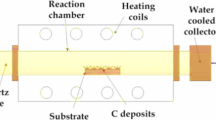Abstract
The influences of temperature, cone height, and apex angle on the tensile and compressive behaviors of open-tip carbon nanocones (CNCs) under axial strains were examined. The tensile failure strain and failure load of the CNC were found to decline evidently as the system temperature increases. The average failure strain decreases with the growth in the cone height. Concerning compressive behaviors, the critical strain and critical load of the CNC reduce manifestly with the increase in the system temperature and the apex angle. As the cone height grows, the critical strain decreases evidently but the critical load has no obvious change. The buckling mode does not have much variation when the temperature increases. It displays a more distorted buckling pattern with the growth in the cone height and transfers from an axisymmetric pattern to an unsymmetrical and more warped pattern when the apex angle expands.









Similar content being viewed by others
References
S. Iijima: Carbon nanotubes: Past, present, and future. Nature 354, 56 (1991).
P.J.F. Harris: Carbon Nanotube Science: Synthesis, Properties and Applications (Cambridge University Press, Cambridge, UK, 2009).
M. Ge and K. Sattler: Observation of fullerene cones. Chem. Phys. Lett. 220, 192 (1994).
A. Krishnan, E. Dujardin, M.M.J. Treacy, J. Hugdhl, S. Lynum, and T.W. Ebbesen: Graphitic cones and the nucleation of curved carbon surfaces. Nature 388, 451 (1997).
S.N. Naess, A. Elgsaeter, G. Helgesen, and K.D. Knudsen: Carbon nanocones: wall structure and morphology. Sci. Technol. Adv. Mater. 10, 065002 (2009).
N.A. Kiselev, J. Hammer, and A.S. Kotosonov: Carbon nanotubes from polyethylene precursors: Structure and structural changes caused by thermal and chemical treatment revealed by HREM. Carbon 36, 1149 (1998).
H. Terrones, T. Hayashi, M. Muñoz-Navia, M. Terrones, Y.A. Kim, N. Grobert, R. Kamalakaran, J. Dorantes-Davila, R. Escudero, M.S. Dresselhaus, and M. Endo: Graphitic cones in palladium catalysed carbon nanofibers. Chem. Phys. Lett. 343, 241 (2001).
M. Endo, Y.A. Kim, T. Hayashi, Y. Fukai, K. Oshida, M. Terrones, T. Yanagisawa, S. Higaki, and M.S. Dresselhaus: Structural characterization of cup-stacked-type nanofibers with an entirely hollow core. Appl. Phys. Lett. 80, 1267 (2002).
B. Eksioglu and A. Nadarajah: Structural analysis of conical carbon nanofibers. Carbon 44, 360 (2006).
S. Iijima, M. Yudasaka, R. Yamada, S. Bandow, K. Suenaga, F. Kokai, and K. Taskahashi: Nanoaggregates of single-walled graphitic carbon nanohorns. Chem. Phys. Lett. 309, 165 (1999).
Y. Gogotsi, S. Dimovski, and J.A. Libera: Conical crystals of graphite. Carbon 40, 2263 (2002).
G. Zhang, X. Jiang, and E. Wang: Tubular graphite cones. Science 300, 475 (2003).
Z.L. Tsakadze, I. Levchenko, K. Ostrikov, and X. Su: Plasma-assisted self-organized growth of uniform carbon nanocone arrays. Carbon 45, 2022 (2007).
I. Levchenko, K. Ostrikov, J.D. Long, and S. Xu: Plasma-assisted self-sharpening of platelet-structured single-crystalline carbon nanocones. Appl. Phys. Lett. 91, 113115 (2007).
J.Y. Hsieh, C. Chen, J.L. Chen, C.I. Chen, and C.C. Hwang: The nanoindentation of a copper substrate by single-walled carbon nanocone tips: A molecular dynamics study. Nanotechnology 20, 095709 (2009).
I.C. Chen, L.H. Chen, A. Gapin, S. Jin, L. Yuan and S.H. Liou: Iron-platinum-coated carbon nanocone probes on tipless cantilevers for high resolution magnetic force imaging. Nanotechnology 19, 075501 (2008).
S.S. Yu and W.T. Zheng: Effect of N/B doping on the electronic and field emission properties for carbon nanotubes, carbon nanocones, and graphene nanoribbons. Nanoscale 2, 1069 (2010).
S.P. Jordan and V.H. Crespi: Theory of carbon nanocones: mechanical chiral inversion of a micron-scale three-dimensional object. Phys. Rev. Lett. 93, 255504 (2004).
P.C. Tsai and T.H. Fang: A molecular dynamics study of the nucleation, thermal stability and nanomechanics of carbon nanocones. Nanotechnology 18, 105702 (2007).
K.M. Liew, J.X. Wei, and X.Q. He: Carbon nanocones under compression: Buckling and post-buckling behaviors. Phys. Rev. B 75, 195435 (2007).
J.X. Wei, K.M. Liew, and X.Q. He: Mechanical properties of carbon nanocones. Appl. Phys. Lett. 91, 261906 (2007).
B.I. Yakobson, C.J. Brabec, and J. Bernholc: Nanomechanics of carbon tubes: Instabilities beyond linear response. Phys. Rev. Lett. 76, 2551 (1996).
B.I. Yakobson, M.P. Campbell, C.J. Brabec, and J. Bernholc: High strain rate fracture and C-chain unraveling in carbon nanotubes. Comput. Mater. Sci. 8, 341 (1997).
J. Tersoff: New empirical model for the structural properties of silicon. Phys. Rev. Lett. 56, 632 (1986).
J. Tersoff: Modeling solid-state chemistry: Interatomic potentials for multi-component systems. Phys. Rev. B 39, 5566 (1989).
J.M. Haile: Molecular Dynamics Simulation (Wiley–Interscience, New York, 1992).
D.C. Rapaport: The Art of Molecular Dynamics Simulations (Cambridge University Press, Cambridge, UK, 2004).
D.W. Brenner, O.A. Shenderova, J.A. Harrison, S.J. Stuart, B. Ni, and S.B. Sinnott: A second-generation reactive empirical bond order (REBO) potential energy expression for hydrocarbons. J. Phys. Condens. Matter. 14, 783 (2002).
Acknowledgments
The authors thank the support provided to this research by the National Science Council of the Republic of China under Grant No. NSC 97-2623-E006-001-MY3.
Author information
Authors and Affiliations
Corresponding author
Rights and permissions
About this article
Cite this article
Liao, ML., Cheng, CH. & Lin, YP. Tensile and compressive behaviors of open-tip carbon nanocones under axial strains. Journal of Materials Research 26, 1577–1584 (2011). https://doi.org/10.1557/jmr.2011.160
Received:
Accepted:
Published:
Issue Date:
DOI: https://doi.org/10.1557/jmr.2011.160




